(This Retrospective article was published in the February 2006 issue of Rider Magazine.)
STORY AND PHOTOGRAPHY BY CLEMENT SALVADORI
It had to happen. Some Japanese manufacturer was going to come out with a V-twin cruiser. The first efforts, though, were a bit strange to students of cruiser aesthetics. But maybe this was due to the fact that Yamaha’s Virago seemed to be almost an afterthought.
Back in the early 1980s Yamaha was bound and determined to outdo Honda in sales—sort of a mano a mano engagement at both the corporate and dealership levels. And one way to do it, Yamaha figured, was to come out with a lot more models. Like a V-twin. The R&D department designed a SOHC, two-valve, air-cooled engine, with a 75-degree included angle between the cylinders. Nothing special about 75 degrees, except that it would take up less space than, say, a 90-degree engine like a Ducati.
It appeared that the Yamaha designers were intent on building a sporty bike with this new engine, using a high-tech semi-monocoque frame with a single shock absorber at the back. Big gas tank, flat handlebars, long saddle, fully enclosed chain final drive, speedo and tach over the headlight, dual discs up front—and in 1981 the European market got a Yamaha sport model called the TR1, with a 981cc engine, having a distinctly oversquare bore of 95mm, short stroke of 69.2mm.
The U.S. shops got a similar bike, called the XV920R (Retrospective, November 1997), with a 920cc engine having a smaller bore of 92mm, the same 69.2mm stroke. This model was not exactly high on the American dealers’ “Wanted” list. The go-fast guys wanted in-line fours, not an underpowered variation on an Italian theme. And why we got the 920 version, instead of the 981, nobody has ever explained—that marketing decision would make a good MBA thesis.
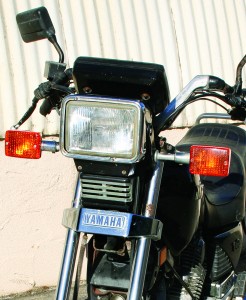
But Yamaha USA wasn’t done, and they presented the XV750 Virago, a cruiser-styled bike with the smallest version of the V-twin, the 748cc engine having a bore of 83mm, maintaining that 69.2mm stroke. It was an odd-looking duck, with that Monoshock rear, no visible frame, a stepped saddle, footpegs slightly forward of normal, a muffler on each side and a blob of a gas tank. But it sold like gangbusters—whatever gangbusters were.
The Virago 750 had shaft drive, which appealed to that non-mechanical crowd that simply wanted to put gas in the tank and go. And self-adjusting cam-chain tensioners. The engine hung off the pressed-steel, box-type backbone frame, which was strong and cheap to build, and had been a mainstay of Japanese chassis construction for 20 years. Americans had taken to the look of tubular frame construction in the 1970s, but Yamaha could get away with the pressed steel because it was entirely concealed. Also, the frame did double duty, serving as an airbox for the two 38mm Hitachi carburetors.
The usual amenities went along with the Virago. A drum brake was on the rear wheel, a single disc on the front. The shock was adjustable for damping and spring preload. The tach was electric, and the turn signals self-canceling.
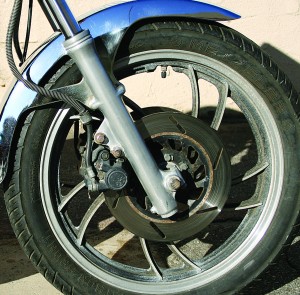
The 750 Virago was a hit, the XV920R a sales flop, and the latter was pulled from the U.S. lineup after the second year. But if that 750 Virago was such a good seller, why not build a bigger one, the marketing types asked—we already have the engine.
For 1982 Yamaha Motor Corp. USA offered two Viragos to the dealers, the 750 ($3,200) and a new 920 ($3,700). Through sensible initial design at the factory, it was not a complicated act to alter the latter’s chain to a shaft drive. And since the two engines were the same externally, virtually the same frame could be used. For the Virago types, the camshafts had been changed to a more discreet lift from the R version, although the R’s bigger 40mm carburetors were still used.
For the $500 boost in price, the buyer got not only 170 extra cc, but a host of other improvements. A second disc brake was mounted up front, though the drum remained at the back. The DeCarbon shock was pretty much the same as on the 750, but with increased spring rates. The fork was much more sophisticated, with a single fitting to adjust the air pressure, and each fork leg had a knob at the top with four rebound-damping positions. It was best to have them both set at the same number. Wheelbase was a tad under 60 inches, and the bike was surprisingly maneuverable.
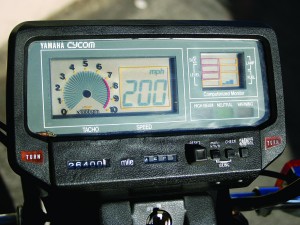
A very trick Buck-Rogerish liquid crystal display was on the 920 Virago’s dash, above a rectangular headlight. This had a semi-analog tach and a digital speedometer, as well as a computer monitoring system that could do useful things like tell the rider when the taillight was not working. Fire up the engine and the instrument panel did its check list, showing the speedo’s capability of reaching 200 mph—although the DOT-mandated, real-life, on-the-road speedo that the rider lived by maxed out at 85 mph. The handlebars were two separate parts bolted to the steering head, each of two pieces, and these could be loosened up and swiveled back and forth for a total of six possible configurations.
Buyers loved the package. It was a good deal cheaper and a lot more comfortable than a Harley Sportster, even if it did have a slightly odd appearance to the American eye.
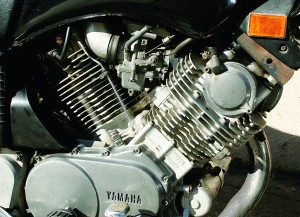
Then Yamaha got serious with the notion of cruiser styling, appreciating that these buyers liked the retro look. For 1985 the Virago got revamped and became the XV1000, using the 981cc motor in a new frame. The engine still served as a stressed member, but now there were conventional twin shocks at the back, over and under mufflers on the right side, and the footpegs were moved forward. The carbs’ air cleaners were now external, chromed plastic sticking out on each side, and chrome was lavishly laid on everywhere else. A regular speedo and tach appeared above the round headlight. This XV1000 Virago sold for a not inconsequential $4,500, the same price as a Sportster.
As an aside, nobody has ever admitted to being the originator of the Virago name. It was a curiosity, with Mr. Webster defining the word as “a woman of great stature, strength and courage” or “a loud overbearing woman.”
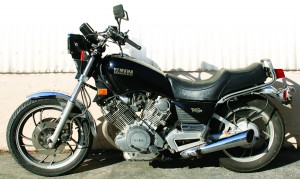
Over the years Viragos grew to 1,100cc, and shrunk to the 250cc size. In 2006 there is but one Virago on the Yamaha list, the 250—everything else is classified as a Star.








I I had one when I lived in Honolulu rode it for over 3 years. . When I return to the mainland I shipped it home with me an rode it another two and a half years. Fun little bike. Well not so Little.
I bought an ’82 VIRAGO 750 as my re-entry into riding bike in ’86. Thoroughly enjoyed all about it except for power. Even 2-up, it made many journeys around the Northwest. Then I’d bought an ’83 GoldWing and rode it for 19 years. But at 77 years old, it just became too top heavy for my arthritic hips. So, remembering the Virago’s pure bulletproof quality, I sought out another one. I now have a ’98 VIRAGO XV1100 V-TWIN and it fits like a glove, looks good despite chromed plastic, is fast and, as my first one, is bullet-proof. No bells & whistles. Just a Plexifaring 3 and I enjoy riding once again. If Yamaha was real smart, they’d bring the Virago back in 750 &1200cc versions back as the Stars just look and ride like all the rest. Styling on the later Viragos was way ahead of the rest. Yamaha, JUST DO IT !!!!!?????
Jim,
Agree.
I have a 95 Virago xv1100 and enjoy every minute of it.
Not interested in the more recent versions.
90s styling, comfort and dependability far more enjoyable.
Hi Jim, do you know if cam chain guides on 82 VIRAGO 750
are compatible with 83 VIRAGO 920 ?
LOOKING FOR REPLACEMENT.
THANKS
Yes
bought a 920 in 83. put about 70,000 miles on it. except for the design issue with the starter not engaging properly, at times, it held up great. the riding height and overall ride was very comfortable for me. adjustable handle bars were great to get the perfect position for me. I put a windshield on it and it kept many unwanted critters out of my face. no helmet law in California back then. many great memories. Big Sur, the Golden Gate Bridge and on and on.
Loved my 92 Virago 920. Put thousands of miles on traveling from Ohio up into the northeast and south into the Carolinas and west past Chicago with my lady friend on the back. Never had an issue with it. Would love to have it back again!!!
Great stories folks. Just got my first bike 04/12/22 and is Virago 1982 X92. Definitely seen better days but I’ll make life out of it . Thanks for your memories.
I had a 82 Virago 920j and put at least 70k miles on it. Rode it everywhere. Loved that bike!
I had a 83 virago xv920,very good bike other than the starter.This was my main transportation winter or rain,I was young and trying to make ends meet.Ya’ll heard of seven bridges road by the Eagles,that was my favorite road to drive.I bought the bike in 85 but it was new just never sold,I got a good deal on it.It was black with chrome fenders.
Looking for replacement of CHAIN GUIDES sets for both cylinders on 1983 Virago xv 920
Please advise!!!!
Thanks
I got mine chain guides from csmnl.com Seems like xv 750 and xv 920 have got same 69,2mm stroke. So, is it possible to swap xv920 cylinder heads onto xv750 engine?
Hi. I’m looking for advice on my 82 Virago. First off did anyone do a carb to throttle body swap? I’m eyeing it seriously, putting 45-55 t.b.s on instead of carbs forvthrottle response and milage. Second did anyone ever sap from a drive shaft to a chain or belt? I spent a lot of time thinking about it and I think the best way to go about it is to get a output shaft machined so a sprocket can be installed, same with the rear rim, and make them interchangeable. While I’m in the guts of the engine I think making 5th gear a little taller so freeway speed isn’t only comfortable but enjoyable.
Anyone have thoughts or suggestions? I want a new bike but being disabled I’m luckto have what I do have and the knowledge of how to learn.